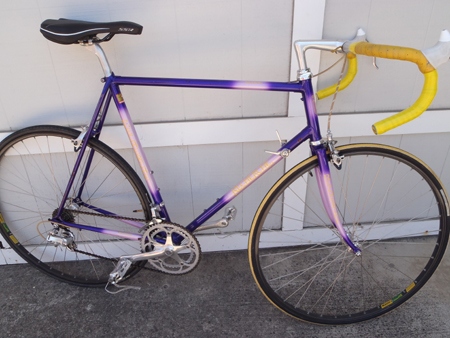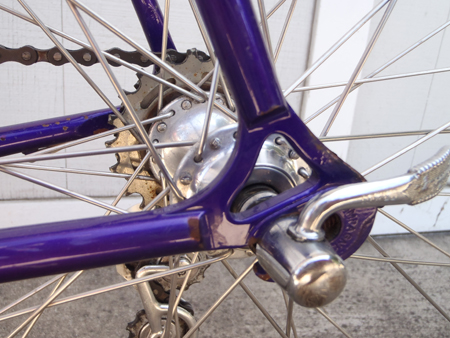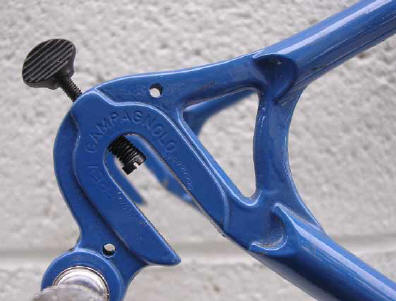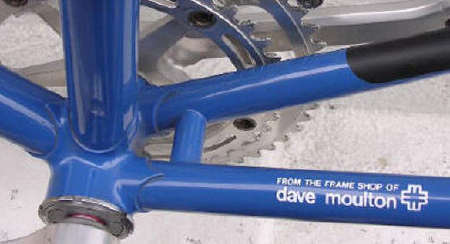Marcella: My number one painter
 Mon, June 4, 2018
Mon, June 4, 2018 
I learned a lot in the fifteen months I worked for Masi, from October 1980 until December 1981. I was hired to assemble and braze frames, and I found by building these in batches of 5 or 10 all the same size, I could build 10 frames a week, 40 a month, quite comfortably.
Other people did the file and finish work, and Masi employed a full time painter. I knew if I opened my own shop I would need to operate in a similar manner. There is a limit to the amount one man can produce, no matter how many hours he may work.
I knew finding a skilled Bicycle painter was not going to be easy. I was actually surrounded by painters, they had all learned their skills working for Masi, People like Brian Baylis, Jim Cunningham, and Jim Alan, but they all had their own established businesses, and would rather have had me subcontract with them to paint my frames.
However, I had always done my own paint, and felt I needed to have my own paint facility, and have complete control over the process. Plus a large chunk of the profit in framebuilding is lost when using a sub-contract painter. I decided I would train my own painter, to do the job the way I preferred, and I could take up the slack during the training process.
I didn’t have to look very far as it happened, the ideal candidate was right under my nose. Marcella Welch was a young girl who delivered the Imron paint to me. She worked for a local Paint Supply Company, drove a little red pickup truck and I would see her almost on a daily basis. If she wasn’t bringing my paint, she would be dropping off supplies for the other above mentioned painters, all working out of the same shop.
Marcella always showed an interest in what we were doing, and one day in quite casual conversation, mentioned that she would “Love to learn a skill like this.” I told her I would be opening my own shop in San Marcos in a few weeks, and there would be a job if she was interested. That is how Marcella Welch became my first full time painter.
The picture at the top of the page was a posed simulation of painting a frame. In reality there was a special device that slid inside the seat tube like a seat post, but with an expanding rubber sleeve to hold it in place. There was a ring on the top were the frame hung securely from the ceiling of the paint booth.
A piece of tube placed though the bottom bracket shell acted as a handle so the frame could be maneuvered with the left hand, while holding the paint gun in the right hand. The painter could rotate the frame, and at the same time twist it in any direction to paint all around every tube.
Painting bicycle frames requires a special set of skills. You can’t paint one side of the frame, the turn it around and paint the other side. The paint where you started would be dry and would not flow out smoothly. Each tube has to be painted separately. This can cause problems as it is easy to get a buildup of paint where the tubes meet at the lugs.
A beginning painter would start by spaying the primer coat. This dries to a matt finish, and has to be sanded anyway before the color coats are applied. Marcella started in 1983 when the new shop opened. The John Howard’s were the frames she would learn on.

The Howard frame had chrome plating to be masked off before the frame is sandblasted and immediately prime coated. The color coat was a single color, then dry fix (Rub on.) decals applied. Followed by eight clear coats over the decals, and after the paint was cured in the paint oven, the clear coats over decals was sanded smooth.
All the steps outlined in the previous paragraph are all procedures that a beginning painter would soon carry out. The final finish clear coat is the most difficult. A wet coat applied quickly so the clear coat flows out smooth with no dry spots. But at the same time not so wet that the paint runs.
With some 300 Howard frames produced in less than a year, Marcella, learned quickly, and within three months was handling all the John Howard painting, including the all-important final clear coat.
Marcella was my number one painter, in that she was the first, in the years 1983 to 1986 when production was at its highest. 300 John Howards, plus all the 1st. Generation Fuso frames, which is probably another 1,000 frames. Add to that the first year’s production of the Recherché.
I recently spoke to Marcella on the phone and we reminisced some. She said it was a lot of fun. She remembered going to the trade shows and seeing people like Bernard Hinault and Eddy Merckx in person.
However, I got the impression that she didn’t grasp the importance, or the lasting value of the work she did. The frames she painted are still out there. Most with the original paint, many still being ridden and enjoyed by their owners to this day.
In 1986 I moved my business the Temecula, sixty mile north of San Marcos. Marcella didn’t care for the daily commute, and left before the end of 1986. She went to work for Cyclart, and painted a number of Greg LeMond frames.
Jay Denny, who is the younger brother of Russ Denny, my former apprentice, took over as painter. He also had no previous experience, but I trained him. Like Marcella, Jay learned quickly and did some fine work. He left around 1990 to pursue other career goals.
My final painter was Morgan Carlton, who unlike his predecessors, had worked for Cyclart and was already a skilled painter. When I left the business in 1993, Russ Denny took over the shop and Morgan stayed on for a while as a freelance painter.










































Supply and Demand
This week a bike I built, (Pictured above.) a Fuso FRX model, is up for sale on eBay. The asking price is $2,500. That is more than twice what it would sell for if it were offered on open auction. More money than it cost new in 1990, when it was built. See this article here.
It is a nice one I will admit, in almost mint condition, it has obviously had little use, but I built 2,400 Fuso frames between 1984 and 1993. They are not that rare. Maybe one of my custom ‘dave moulton’ bikes, if it were in this condition, might go for over $2,000, but I only built 216 of those. Big difference.
How about “Demand,” the other side of the equation? I have a Registry that has (At the time of writing.) 358 Fuso bikes listed. Some owners have more than one Fuso in their collection, so this is less than 358 owners. Not a large number considering there were over 2,400 built.
These are owners who care enough about the Fuso brand to email me with details so I can add their bike to the list. So let me ask this. Given the relatively small number of true Fuso enthusiasts, how many would be owners are waiting in the wings, on the lookout for a frame or bike to buy? Not many, and not at these outrageous prices.
The problem Is, the bikes on eBay offered at these high prices, rarely sell. They just sit there for weeks on end, then they disappear for a while, only to be relisted again at a later date, at the same high price. So when someone happens to inherit a Fuso, or they find one in a thrift store, or garage sale. (It does happen.) They see these greatly inflated prices on eBay, and think they have struck gold.
The “Supply and Demand” factor came into play when the frames were built. There were more of the mid sizes built, 56, 57, and 58 centimeters. These were in greater demand, because there are more cyclists that fall within these sizes. The next most popular were the sizes above and below these sizes, namely 59, 60, 61, and 53, 54, 55 centimeter.
There were fewer very large and very small sizes built because there were less people needing these sizes. The same supply and demand factor applies today. There will be more demand for the mid-size frames, however, there will be more of these coming up for sale, because there were more of the built.
Conversely, the very large or very small frames are in less demand, but there were fewer built. This means if an extreme large or small frame comes up for sale, you may get it at a bargain price, because you are the only one needing that size. On the other hand if there are two or more bidders, the price will go higher.
The buyer then has to make a decision. Pay more, or wait for another to come along in this size, knowing it might be a while because of its comparative rarity. Whether you pay more or not, depends a lot on the frame’s condition. If, for example the paint is really nice, pay a little extra. If the paint is rough, let it go.
Educate yourself by following sales on eBay and Craig’s List. Join the “Dave Moulton Bikes” group on Facebook. Members there are always posting and discussing bikes for sale. I have no financial interest on any frames sold online, so I have no interest in influencing prices. I just hate to see anyone get ripped off, whether they are buyer or seller.
I try to maintain interest in the brands I built, John Howard, Fuso, Recherché, etc., with this blog, and my Registry. My loyalty is with the people who own and ride bikes I built, not those who wish to profit unfairly with over-inflated prices.
I will not be building any more frames, so the supply will never increase, but there are still plenty out there in people’s basements and garages, waiting to be discovered. When the list of Fuso owners on my Registry reaches a thousand, I will consider there is a demand.